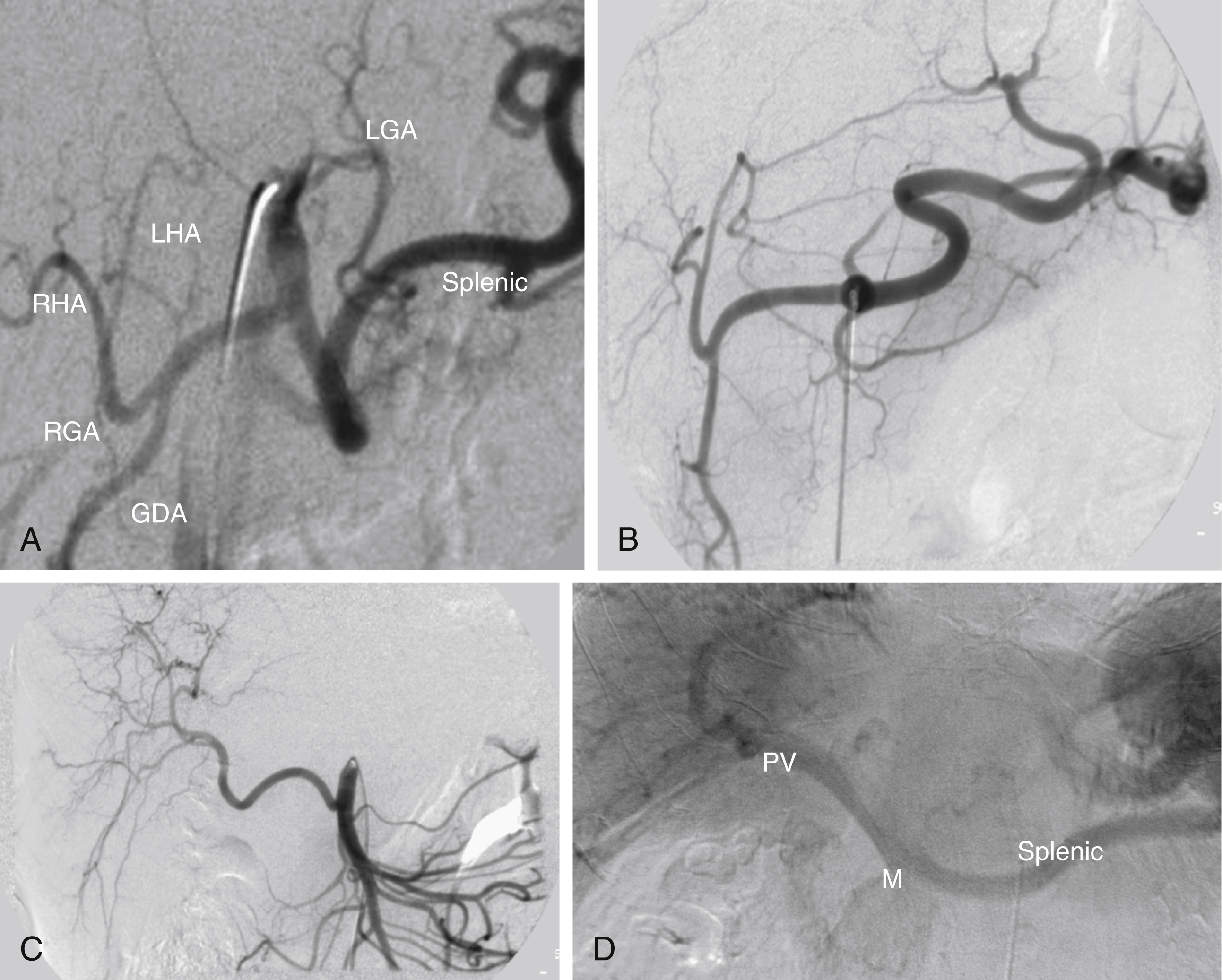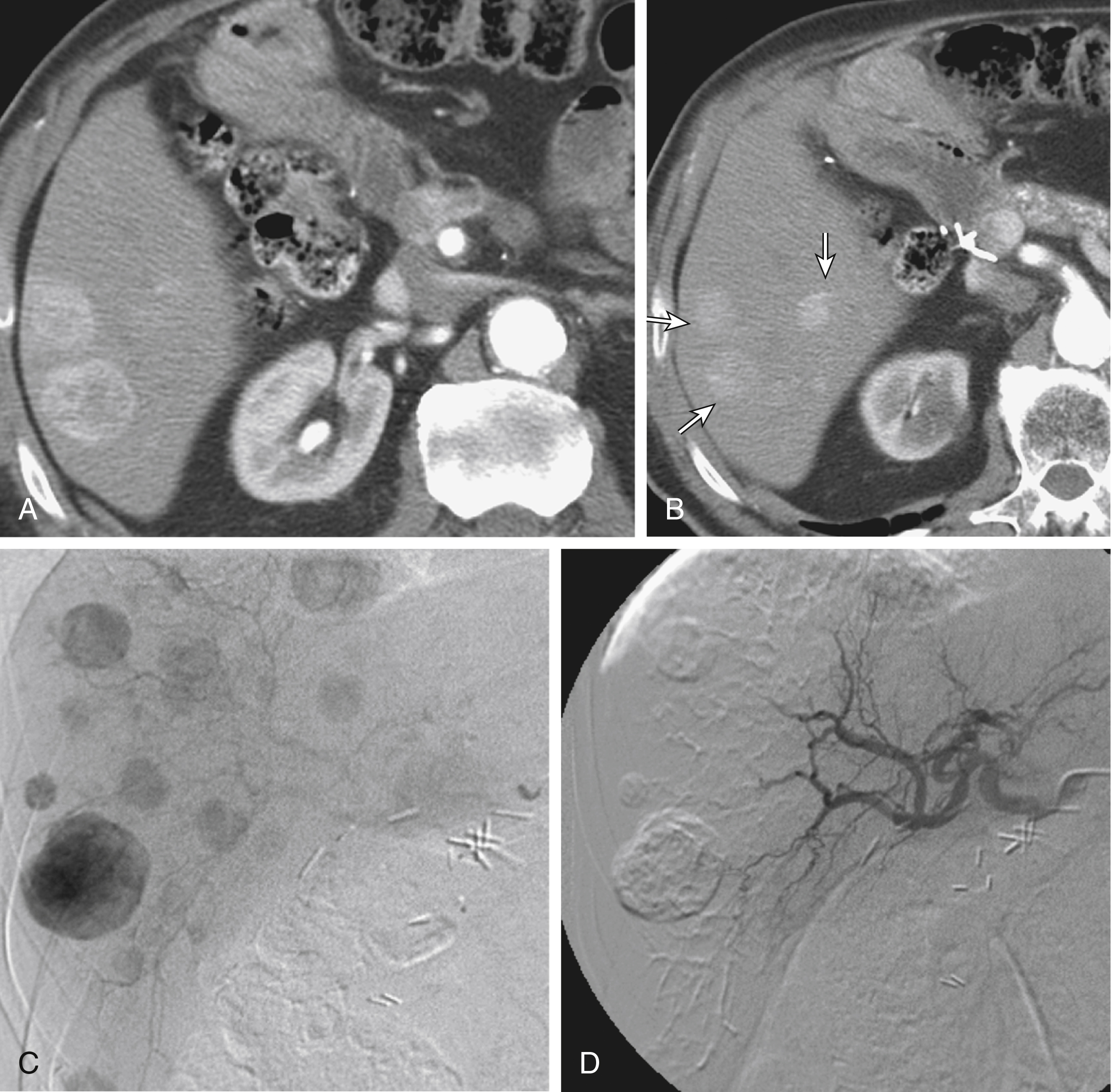Physical Address
304 North Cardinal St.
Dorchester Center, MA 02124
Patients who have liver metastases that are not amenable to resection or ablation generally have poor survival rates. Liver metastases from neuroendocrine tumor (NET), sarcoma, colorectal cancer (CRC), melanoma, and pancreatic cancer can be treated using transarterial embolization (TAE) or transarterial chemoembolization (TACE).
The normal liver ( Fig. 36.1 ) is mostly supplied by the portal vein, whereas hepatocellular carcinoma (HCC) and hypervascular metastases (such as neuroendocrine tumor) are mostly supplied by the hepatic artery. Hypovascular metastases (such as CRC) also have more hepatic artery supply compared with the liver parenchyma. TAE and TACE result in selective intratumoral deposition of particles and chemotherapy because of selective catheter positioning and preferential arterial flow to the tumor. This can result in tumor necrosis, due to both the high local concentration of chemotherapy and the ischemia induced by microparticles occluding tumor arterioles. For both hepatocellular carcinoma and NET, outcomes after TAE and TACE are similar, suggesting that ischemia is the dominant mechanism causing tumor necrosis. For CRC liver metastases, TACE using irinotecan-loaded drug-eluting beads (DEBIRI) improves overall survival. There is limited data on using TAE to treat CRC liver metastases.

In general, patients with unresectable and unablatable liver-dominant metastases ( Fig. 36.2 ) are possible candidates for TACE or TAE. Ideally, patients should be evaluated at a multidisciplinary tumor board to choose the best possible therapy for each patient. At our institution, liver metastases from NET and sarcoma are generally treated using TAE as the initial intraarterial therapy. TAE could potentially also be performed for liver metastases from other primaries, but data on efficacy is limited outside of NET and sarcoma. At our institution, intrahepatic cholangiocarcinoma and liver metastases from colorectal cancer and breast cancer are generally treated using yttrim-90 radioembolization as the initial intraarterial therapy. (See the Outcomes section for a review of the data underlying these institutional preferences.)

For NET liver metastases, arterial therapy is generally reserved for patients with progressive liver metastases who are either symptomatic or have a large tumor burden. This is because NET is typically an indolent neoplasm that can require many repeated embolization procedures over several years. To reduce the number of procedures and the potential cumulative toxicity, asymptomatic small-volume NET liver metastases typically do not need to be embolized immediately. This is in contrast to HCC, for which patients with viable tumor in the liver should generally be treated rather than followed. Symptoms from NET include pain from bulky tumors, and hormonal symptoms: carcinoid syndrome (wheezing, flushing, diarrhea, right-sided heart failure), Zollinger-Ellison syndrome (peptic ulcers from gastrinoma), hypoglycemia from insulinoma, and hyperglycemia from glucagonoma. Patients with NET liver metastases should be evaluated for possible resection of the primary tumor, which is associated with improved survival.
The degree of tumor enhancement on arterial-phase computed tomography (CT) or magnetic resonance imaging (MRI) did not predict outcomes after radioembolization, TAE, or TACE and therefore cannot be used as a selection criterion for one arterially directed therapy over another. Poorly enhancing tumors on cross-sectional imaging can have the same response to arterially directed therapies as avidly enhancing tumors.
Patients with bilirubin >2 are poor candidates for lobar embolization, and patients with bilirubin >3 are poor candidates even for segmental or subsegmental embolization, due to the risk of liver failure. Patients with poor functional status (Eastern Cooperative Oncology Group scale >1) might not tolerate TAE or TACE. Patients with >50% of liver replaced by tumor have poor survival after TAE, but this is not necessarily a contraindication to treatment, because those patients would likely have even worse outcomes without treatment.
Patients should also be evaluated for contraindications to angiography, such as pregnancy, thrombocytopenia, or coagulopathy.
From a femoral approach, generally a 6 F sheath is placed, and the celiac artery and superior mesenteric artery (SMA) can be selected using a 5 F Cobra 2, Simmons 1 or 2, or Sos 2 catheter. The Simmons catheter can be formed over the aortic bifurcation, or using the Cope suture technique, using a 4-0 Tevdek or 4-0 Ethilon suture and Bentson wire. A wide variety of microcatheters and microwires can be used to select the desired artery. For example, a 2.8 F Renegade Hi-Flo microcatheter could be used with a 0.018-inch double angle Glidewire or 0.018-inch Transend microwire. For challenging cases (sharp turns, unable to advance the microcatheter over the microwire), a Direxion J tip or 2.0 F Progreat microcatheter and 0.014-inch Fathom microwire can be helpful.
Embolization can be performed using Embospheres (40–120 micron, 100–300 micron, and 300–500 micron, Merit Medical, South Jordan, UT). Polyvinyl alcohol (PVA) foam particles (90–180 micron) can be helpful for shutting down flow in an artery with persistent flow after using spherical particles. DEBIRI can be performed using irinotecan loaded onto LC Bead microspheres (100–300 micron).
Contrast enhanced MRI or CT of the liver should be obtained before treatment, ideally including arterial and portal venous phases. MRI is more sensitive for detecting small tumors, but CT is higher resolution and often shows the vascular anatomy more clearly. CT can show tumor supply from nonhepatic arteries, such as the phrenic artery.
In our practice, patients receive cefazolin 1 g intravenously (IV) preprocedure. Patients with a history of bilioenteric anastomosis or other biliary intervention receive cefotetan 2 g IV. Postprocedure, these patients (with a history of biliary intervention) receive antibiotics for 5 days and are discharged home with ciprofloxacin 500 mg by mouth twice a day and metronidazole 500 mg by mouth three times a day. Patients with neuroendocrine tumor receive octreotide 250 μg subcutaneously preprocedure.
Become a Clinical Tree membership for Full access and enjoy Unlimited articles
If you are a member. Log in here